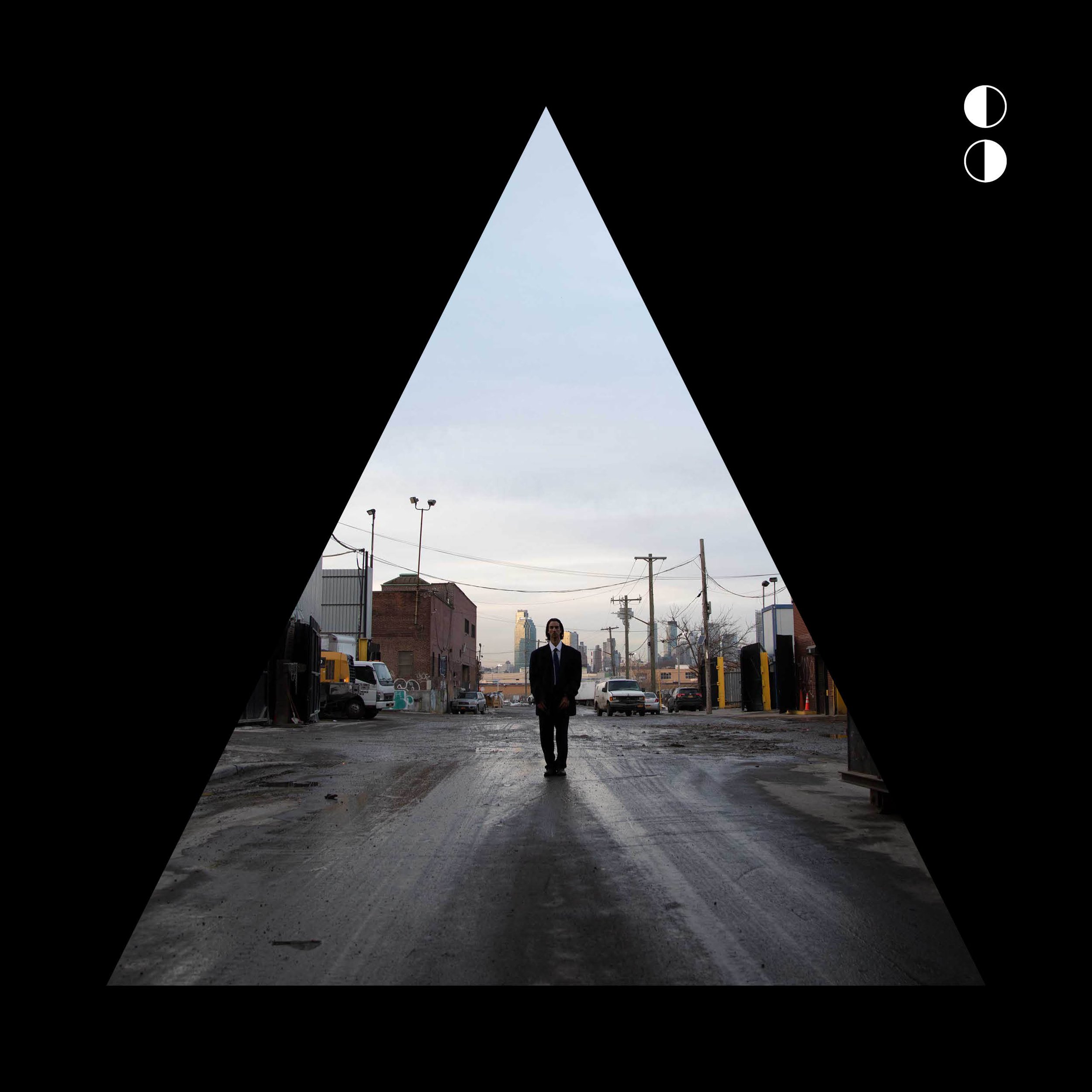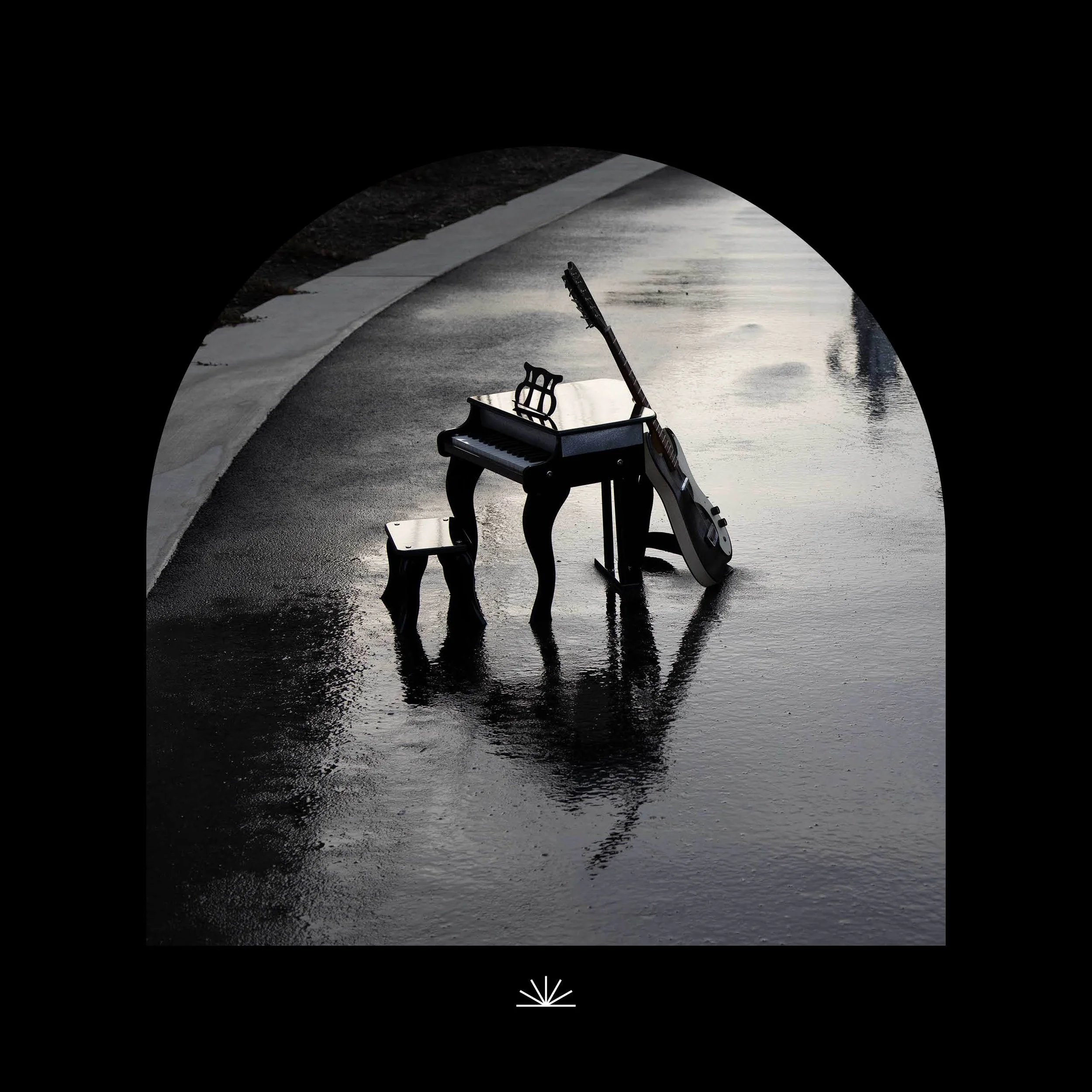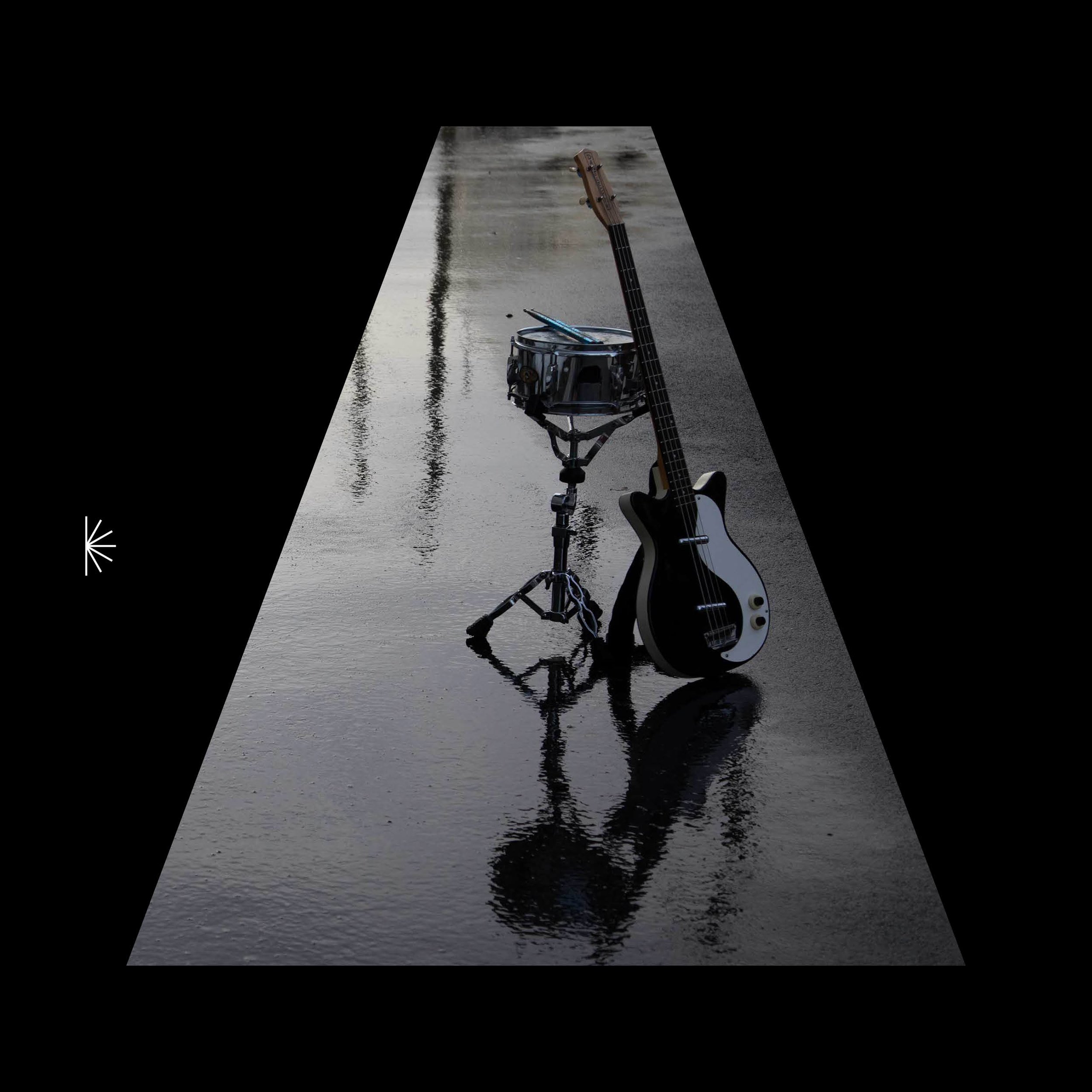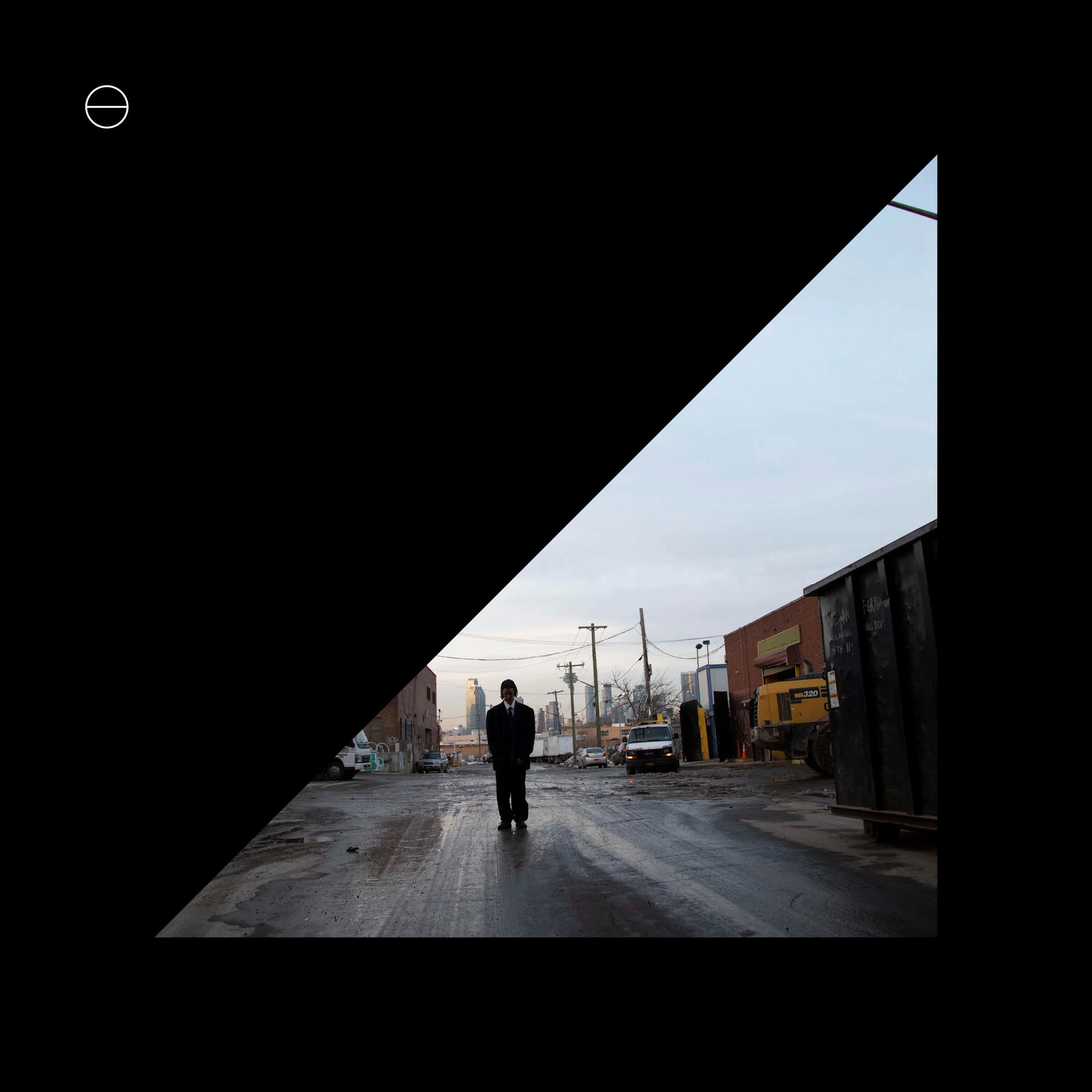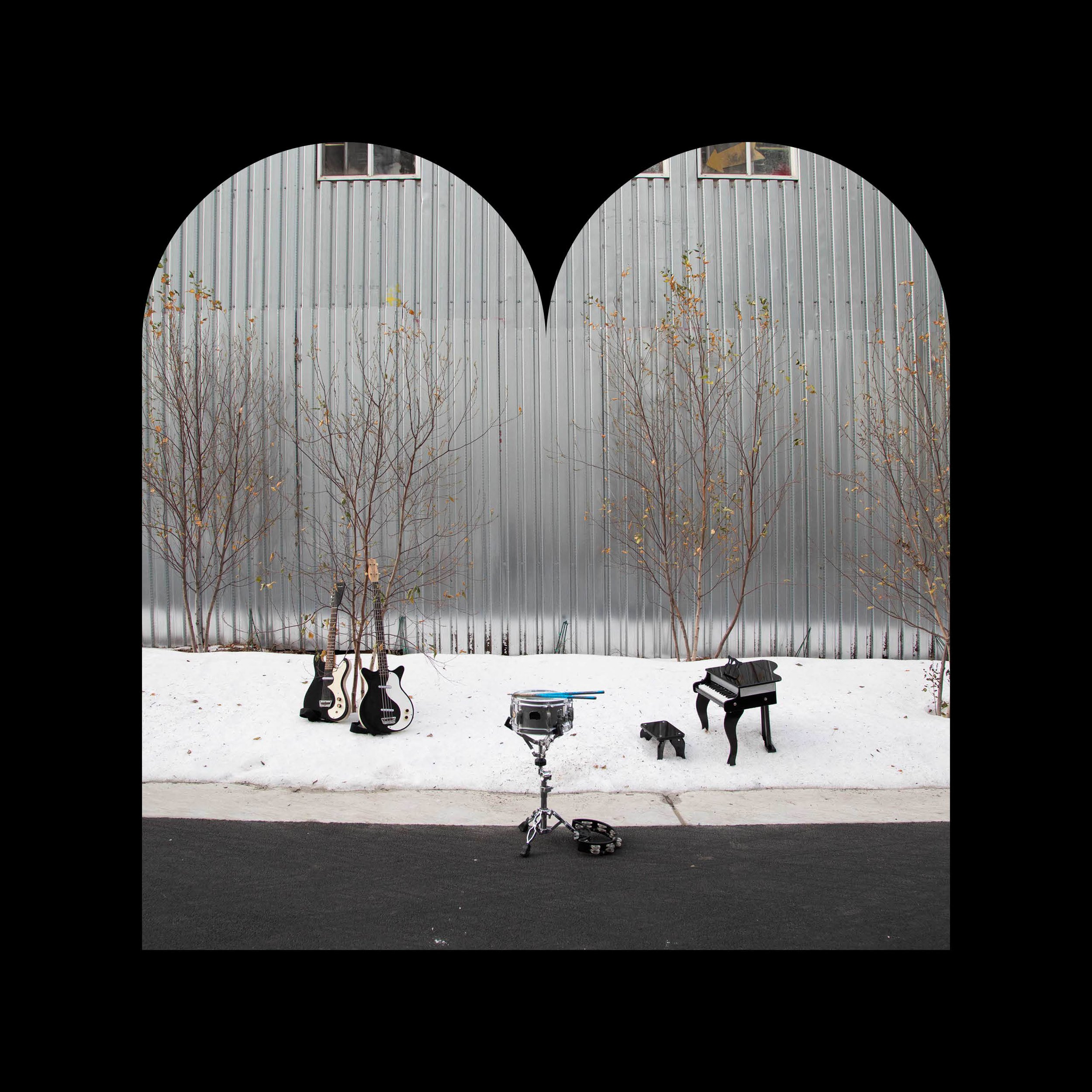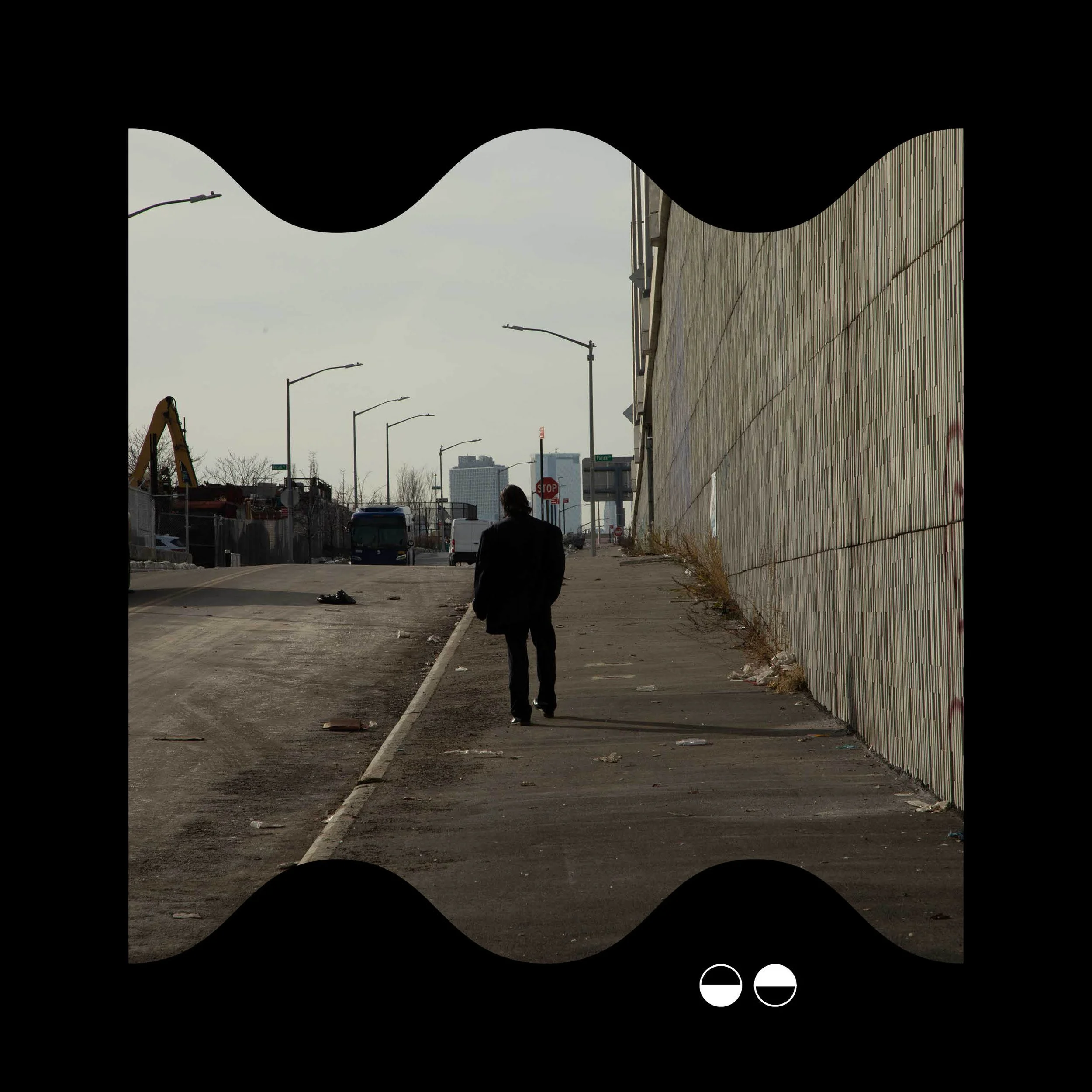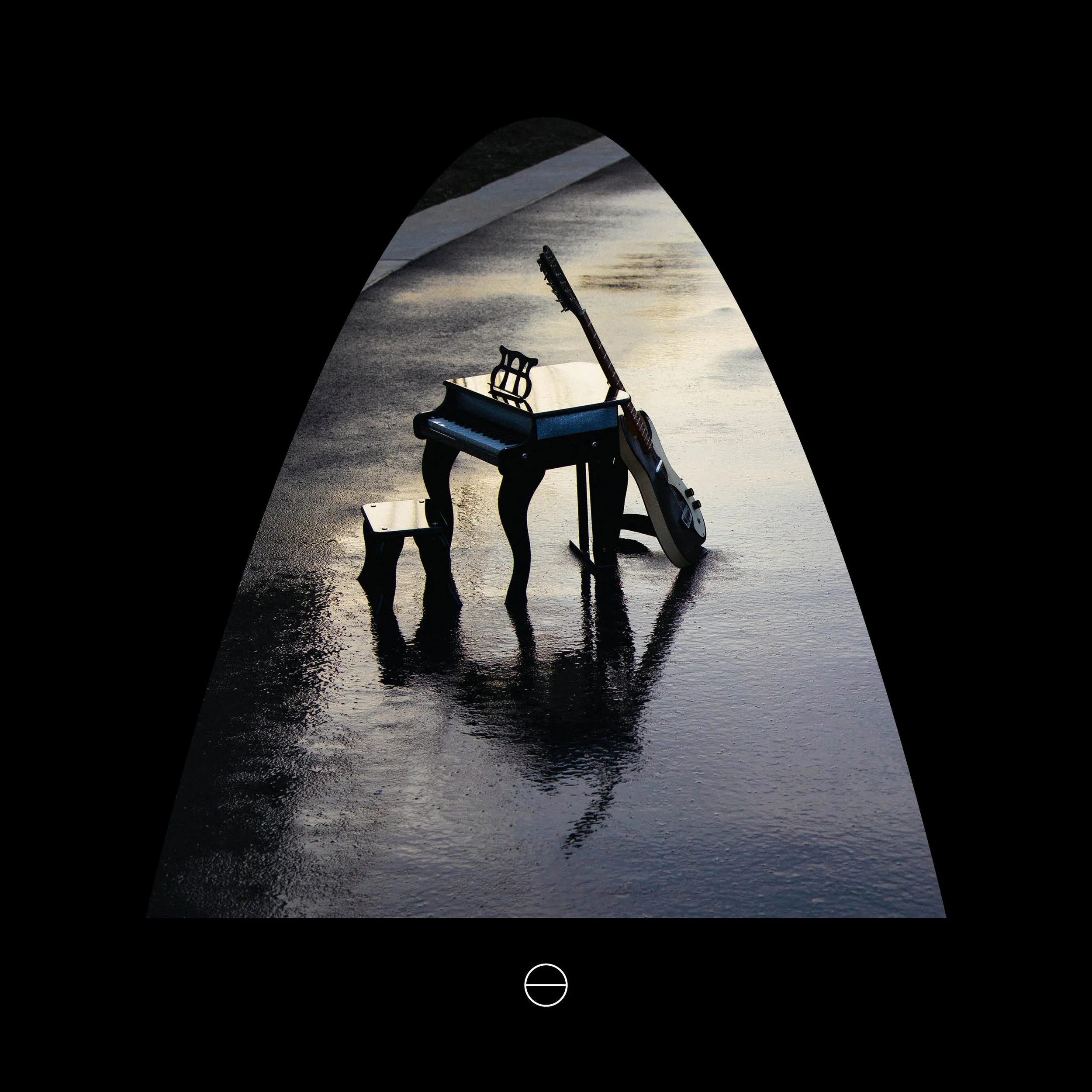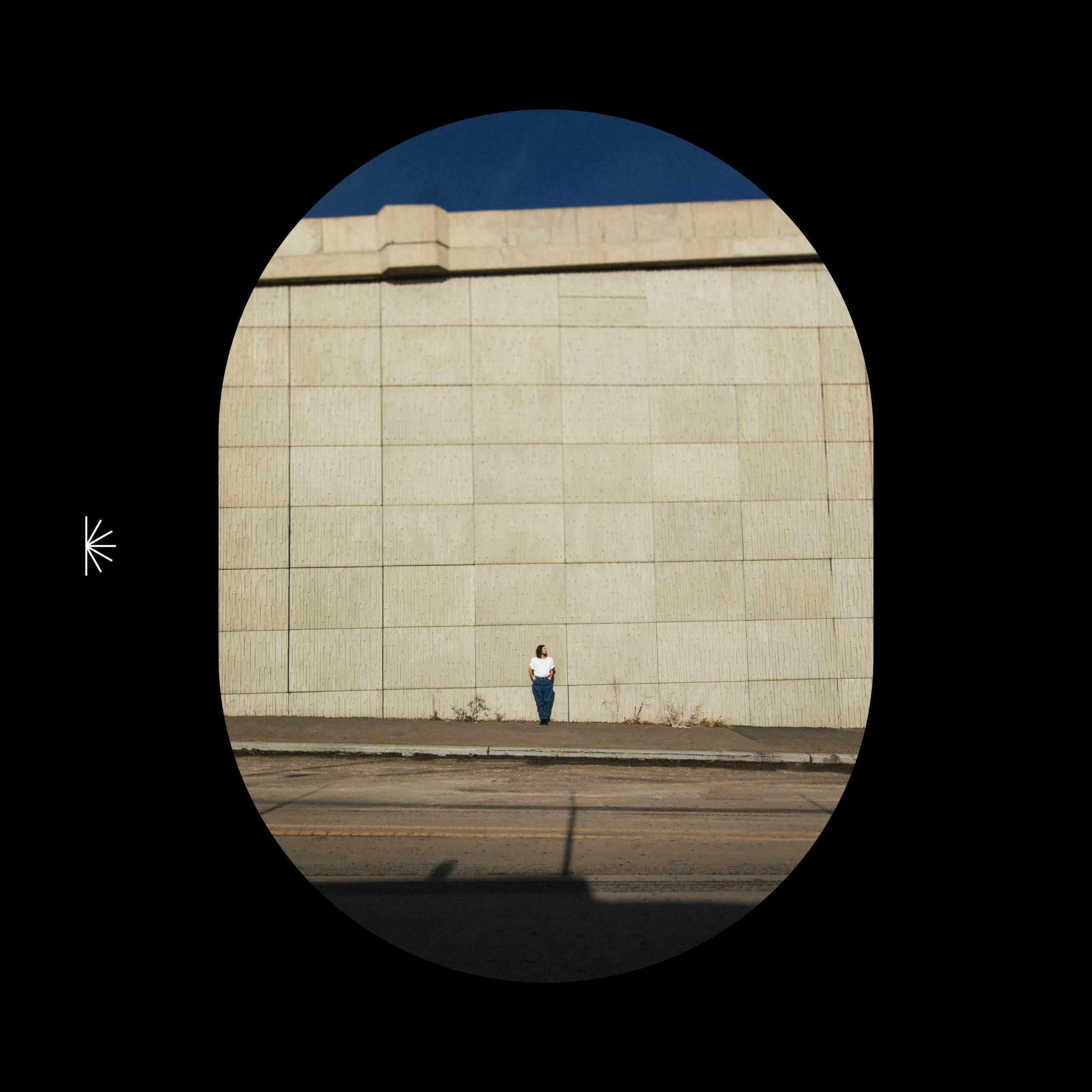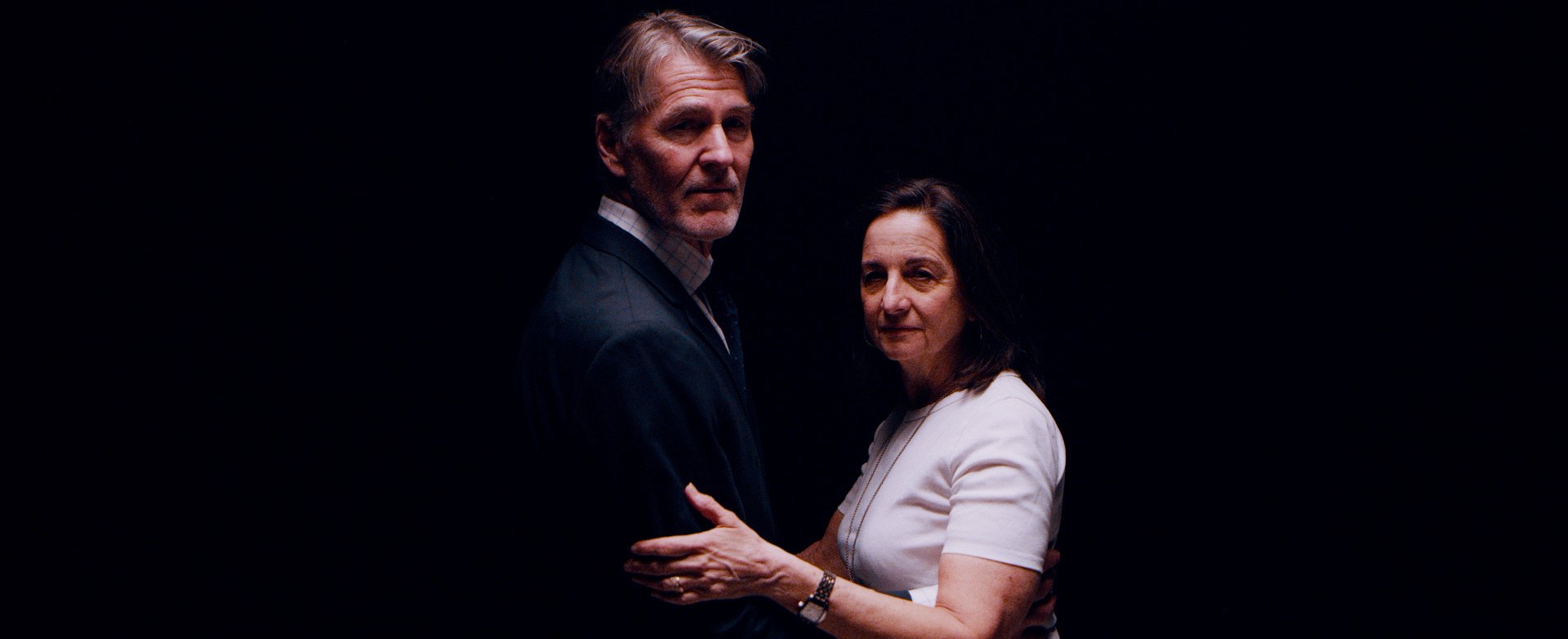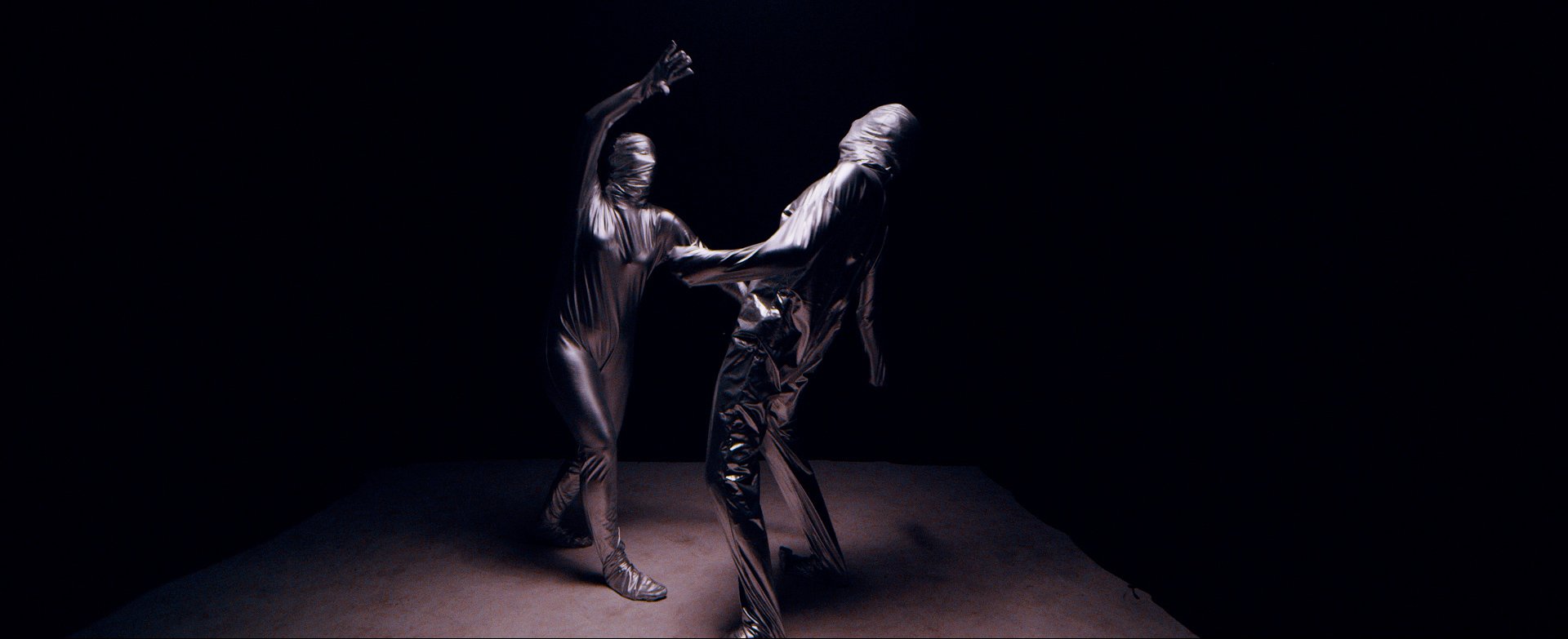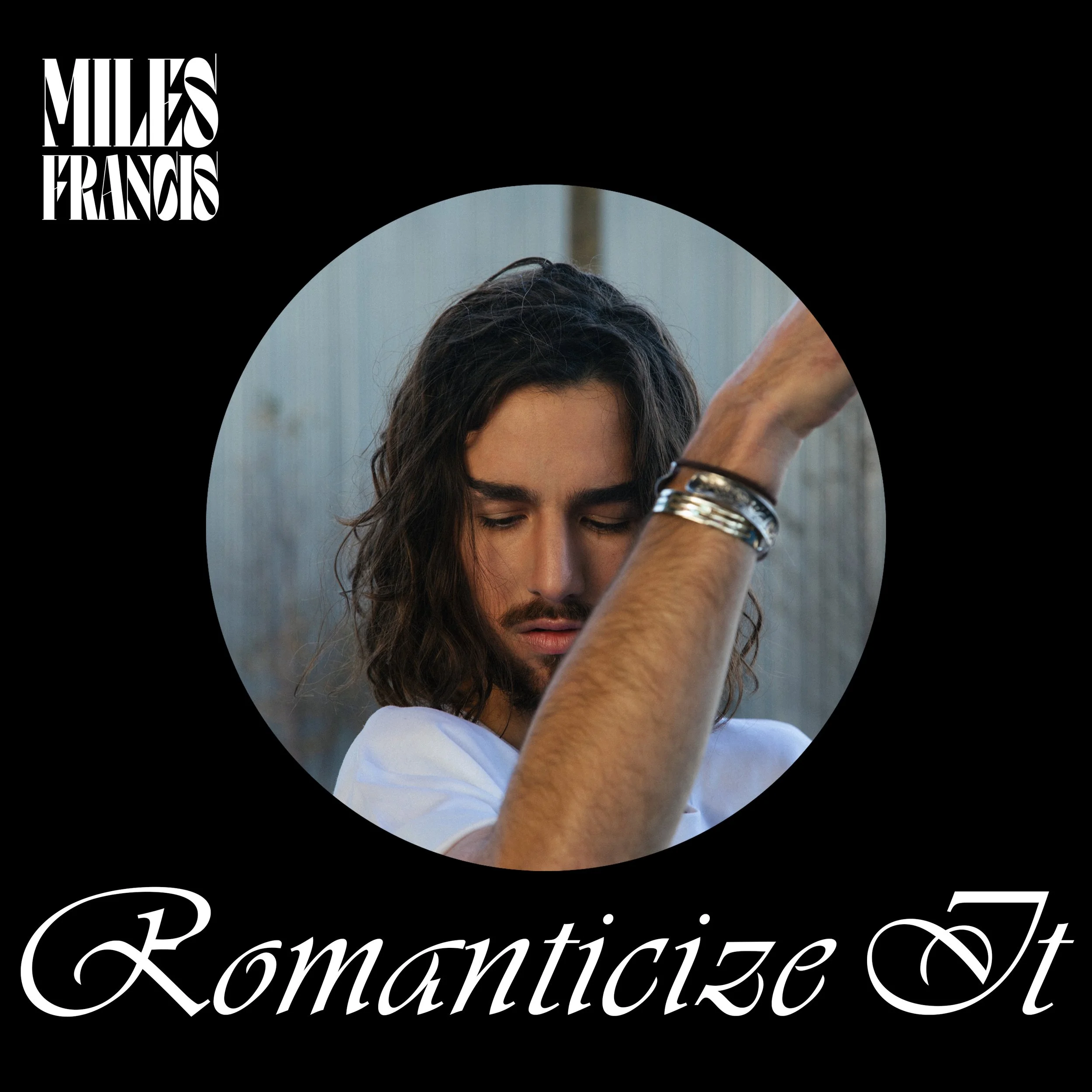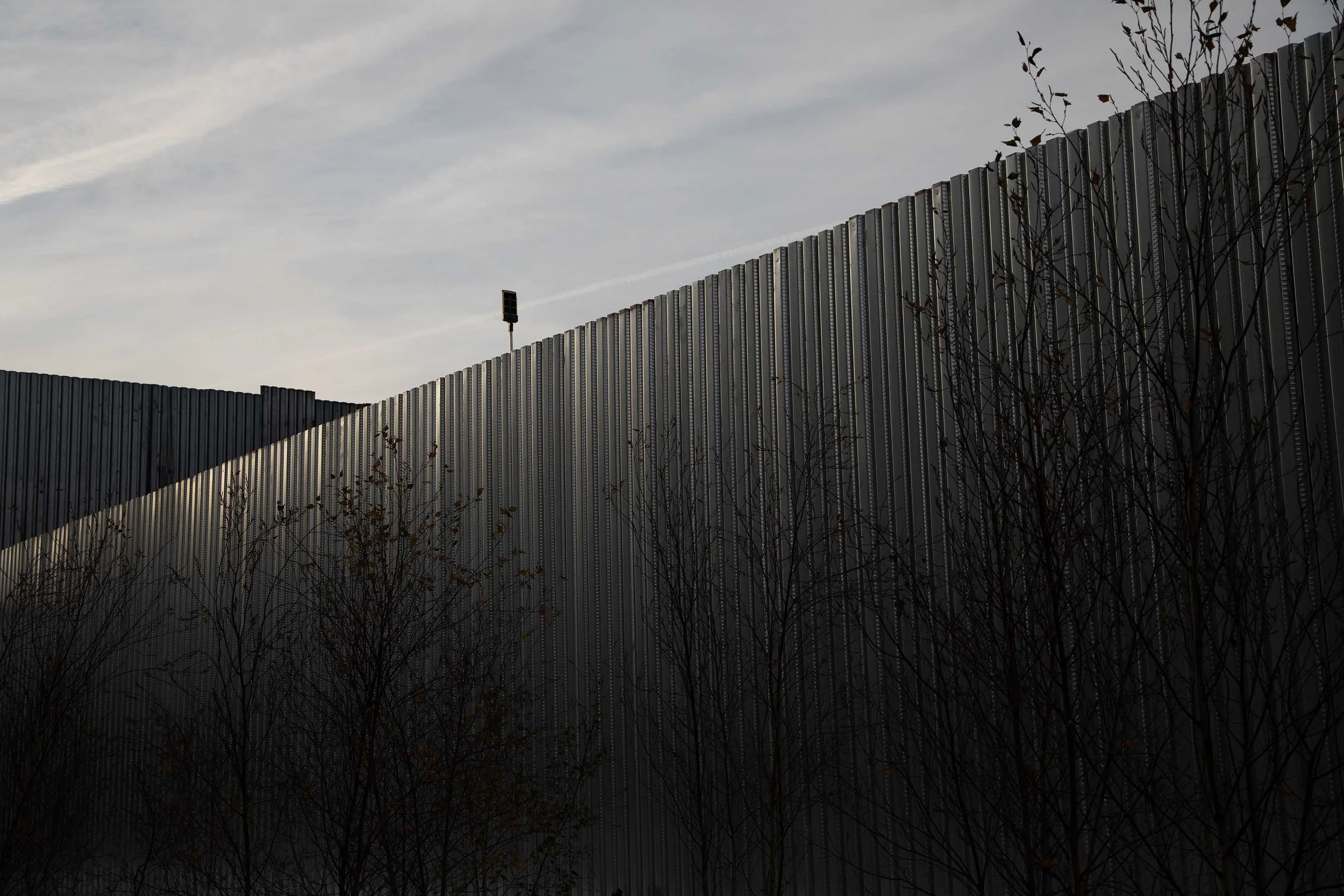
INTRODUCTION
(EAR TO THE WALL)
-
Violins, viola, Yamaha CS-01 II monophonic synthesizer, trumpet, euphonium and baritone saxophone
-
This melody closes the album in “Don’t Fight Anymore,” and as I got closer to finishing the album the melody kept sticking in my head as a theme. I highlighted the strings, horns, and Yamaha tracks from underneath the madness of the “Don’t Fight Anymore” outro, and it sounded exactly like this. I especially liked how you could hear the breathing of the players as they collectively began each phrase. More on the intro and interlude in the section underneath “Interlude (Eye on the Door).”
SERVICE
-
I can be your chaperone / Take you to the party and leave you alone / OK?Whatever it takes, whatever it takes / I’ll do anything for you, I’ll do anything for you / I can be your sous chef / Kitchen running smoothly so you are not stressed / OK? Whatever it takes, whatever it takes / I’ll do anything for you, for you, for you / I am at your service, at your beck and call / I am at your service, giving you my call / All for you, all for you / I am at your service, at your beck and call / I am at your service, giving you my call / All for you, all for you / I’ll do anything for you / All for you, all for you
-
Schecter Hellcat-VI (bass & guitar parts), drumkit, Tempest drum machine (static sounds), tambourine, electric guitar (for 9 seconds in the middle), shekeres, violins, viola, baritone saxophone, Yamaha CS-01 II monophonic synthesizer, Casio CZ-1000 polyphonic synthesizer, layered background vocals and lead vocals
-
“Service” is about devotion, however nervous and impulsive. I wanted to take a pop cliche like “I’ll do anything for you” and give it a dark edge. The song sets up a character, raising questions without answering them, to be unpacked in future songs: Why are they so desperate to offer support? What is their motive? Why are they like this?
I grew up on boy bands, so I wanted to make a boy band-type song with an anxious tinge. I focused on using staccato textures to give it a jolting angular feeling. I’m obsessed with the intersection of Fela Kuti and Prince - this song is my own synthesis. I recorded the guitar and bass first, playing along with a drum machine. Then I muted the drum machine and played live drums, and finished it off with the vocals and synths. The song also features some friends from the NYC afrobeat scene: Lollise Mbi and Giancarlo Luiggi on shekeres, and Maria Eisen on baritone saxophone; as well as a three piece string section (Camellia Hartman, Meitar Forkosh, and Midori Witkoski).
The video is the introduction of a character who is hitting all the steps but is clearly not comfortable or suited for their position. It is a cry for help, masked as a boy band dance routine. These musicians are clearly being directed by some mysterious and ominous outside force, and they are trying to keep it all together - until it unravels at the very end.
The video was directed by Charles Billot, my longtime visual collaborator. I choreographed the acting and dancing in the video, so that when we filmed each “Miles,” I knew how to interact with myself. Throughout quarantine I started cloning myself in my studio for little video posts, calling it MultiMiles. I did it mostly out of a need to play with other people at a time when I couldn’t. Recording myself in my studio - tracking each part one by one to form a full band sound - is something I’ve done since I was 10 years old. It is my greatest joy and love. The MultiMiles videos were finally a way to show to the outside world what I do in my mind when I make music.
GOOD MAN
-
Can I have this dance? / I’m one for romance / An air of streetwise / With valedictorian eyes / Are you impressed when I puff out my chest? / Well, either way… / Gonna get myself a girlfriend / Supply my own demand / Find me a business partner and a plan / I’m a man (he’s a man, he’s a good man) / You’re a man (you’re a man, you’re a new man) / We’re all men (we’re all men, yes we can) / We’re all men / Rebellious charm / My first love was mom / Evolved with the trend / With all my man friends / Are you impressed when I puff out my chest? / Well, either way… / Gonna get myself a girlfriend / Supply my own demand / Find me a business partner and a plan / I’m a man (he’s a man, he’s a good man) / You’re a man (you’re a man, you’re a new man) / We’re all men (we’re all men, yes we can) / We’re all men, I’ll sing it again / Gonna get myself a girlfriend / I’m doing all I can / Find me a business partner to call a friend / I’m a man (he’s a man, he’s a good man) / You’re a man (you’re a man, you’re a new man) / We’re all men (we’re all men, yes we can) / We’re all men (we’re all men, yes we can)
-
Korg MS-20 mini (bass line), snare drum, Linn Drum (kick drum), shekeres, woodblock, Maestro Rhythm King, jingle bells, Ghanaian djembe, electric guitar, acoustic guitar, violins, viola, baritone saxophone, Casio CZ-1000 polyphonic synthesizer, pitched voice, layered background vocals and lead vocals
-
"Good Man" is about a particular patriarchal phenomenon that I've grown increasingly mindful of in the men around me and in myself too as a masc non-binary person. It's sung by a man who preaches progressive values, who identifies as "one of the good ones" - yet he fails to recognize his perpetuation of patriarchal behavior in his own life. He's a nice guy, loves his mom, is evolved and stands for equality - but he still doesn't recognize the privilege and entitlement he himself holds as he moves through the world. There are lots of outwardly 'bad' men out there, we all know that - but it's the ones who claim their "good"-ness that can be particularly troublesome and capable of causing real harm. The songs on my album follow someone wrestling with their true nature, and at the heart of that process is the question of what "being a man" even means.
This song grew out of a rhythmic concept that I learned from artists like Prince and Fela, where you feel a double time beat as if it’s a half time beat. I started with the Maestro drum machine playing a slow tempo, and tracked the drums on top playing double time. It gives a standard rock beat a different rhythmic dimension. To give it even further dimension, the kick drum was played on a Linn Drum while the snare was played live.
LET ME CRY
-
Pent-up heart, a father of stone / Fortified with muscle, stuck in baritone / Glimpses in mirrors, a shell he doesn’t recognize / Reverberating with calls from a child inside / Let me cry / Like I did when I was five / Before the well ran dry / Manning up, winning the bread / A pressure cooker, coming to a head / Indoctrinated against moving his hips / For fear that it could attract another man’s lips / Let me cry / Like I did when I was five / Before the well ran dry / A voice to listen to / Left behind in your youth / What kind of man were you / Before the well ran dry?
-
Roland TR-909 Drum Machine, Moog Voyager (lead line), electric guitar, electric bass, live claps, conga, Ghanaian sogo, live toms (each recorded separately), live cymbals, shakey bells and tambourine, Nord Wave (pads in the choruses), layered background vocals and lead vocals
-
"Let Me Cry" is based around the idea of communing with the inner child. I wrote it thinking about my uncles and other older men in my life, wondering what they were like as children, and how they came to be who they are now. I wondered, what if a man's inner child were to confront their adult self? What would that child ask for, what would they wish? Everyone starts from the same place, regardless of gender - as children, we let our emotions go, uninhibited and in touch with our vulnerabilities. As we age, we go through a "boxing in" by family or society, and over the years that boxed-in state becomes our personal standard for behavior, our comfort zone - unless we can break out. Men's boxing-in process, in particular, holds repercussions for everyone, as it leads to various problematic complexes and ways of lashing out at the world around them.
The music video is a one-shot improvised performance alongside the Brooklyn-Queens Expressway, where most of my album visuals take place. None of the movement was pre-planned - it's a raw moment, capturing a struggle to access emotions.
This song started with the drum machine beat - I was trying to access a certain Fela Kuti groove with electronics, knowing that it’d come out feeling completely different - and that was the point. The song’s harmony is based around the practice of putting different chords under the same note or melody - the verse has one chord progression under the melody, but the chorus changes the chord progression while keeping the same melody. This creates a feeling of recontextualization, like you’re showing a new camera angle on the same subject.
POPULAR
-
I’ve found what I live for / I’ve found something to get me through the day / That long day / Loving is such a chore / I get the same attention from those who hate / That good hate / I don’t ask for much / Just your constant attention / Throw what you got my way / I live to be popular / We all need something more / Don’t you want to escape that tired brain / Well that’s okay, that’s okay / I don’t care for you / Don’t really care for me / Just need that rush / From what you have to say, because / I live to be popular / In control, in control, they all know / I do not thrive on much / Just your constant attention / I was just raised this way / I live to be popular
-
Live kick drum and snare drum (recorded separately), digital cymbal, DSI Tempest (loop pattern), Korg MS-20 mini (bass line), electric guitars, tambourine, Bontempi GT 709 (kids keyboard), layered background vocals and lead vocals
-
“Popular” is a dive into one of the darkest recesses of the male mind and body: the need to take up space. The constant hunger for popularity is widespread across gender, of course, but men have a particular obsession that transcends Instagram - it’s about power. Whether over a country or a conversation, power is essential to the male ego. That ego is a house of cards, of course, threatened by even the slightest loss of control - and I wanted to illustrate that precarity in the song.
I wanted the song to feel like it is speeding up without actually speeding up. The beat is a fast country two-step type of beat, but with a heavy emphasis on the half-time feel, which is something I learned from listening to Prince. The song features Lizzie Loveless and Lou Tides (aka Lizzie and Teeny Lieberson, formerly of TEEN) on background vocals.
The video picks up where “Service” left off, with the main character being dragged to a makeup chair for his punishment. He is initially tormented and clearly being forced to play along, as a silver hand transforms his makeup and outfit - but by the time he is thrown onstage, he eats it up, and embraces his newfound attention. I wanted to show how easy it is to embody your narcissism when given the opportunity.
The video was directed by Charles Billot, who directed “Service”. The makeup was done by Nina Carelli, who did my makeup live in the video. The stage scene was the first time I had been on a stage as ‘Miles Francis’ since quarantine, so when it came time to play the part of “rockstar”, all of this latent performing energy came rushing back. It felt amazing, even though I was playing to an empty room. I truly cannot wait to get onstage and perform again.
HELP ME UP
-
I’m drunk, and I’m tired of feeling this way / But I can’t stand the weight, I’m not gonna change / Shaken up, the same cycle every day / I build it up ‘til it breaks down / Help me up, I’m one with the ground / Nowhere but down for me / Can you help me up, I beg of you now / Help me up, don’t let me down / I’m done acting like I’ve got it all down / Pretending I’m in control now that you’re gone / Are you gone? / Help me up, I’m up against gravity / Waiting for you to look back and see / I’ve fallen / Can you help me up, I beg of you now / Help me up, don’t let me down / Help me up, I’m on my knees / Help me up, you’re stronger than me / Can you help me up, I beg of you now / Help me up, don’t let me down
-
Korg MS-20 mini (bass line), electric guitars, Linn Drum, live kick drum, DSI Tempest, Moog Prodigy (melody line in the choruses), Hammond Organ, Casio CZ-1000, piano, baritone saxophone, violins, viola, layered background vocals and lead vocals
-
The core instrumental elements of this track were made years ago and sat on the shelf - I knew I wanted to make something of it but I could never find the path to finishing it. I even felt a little pressure to make the vocal melody and end product as “good” as the instrumental. I had a couple versions of vocal melodies that I tried out and sat with for a while, but they weren’t hitting like I wanted them to.
In parallel with this song’s creation, I had made another song called “Help Me Up.” I loved the song and the instrumental, but it also sat on the shelf for a while. One day, I started singing the lyrics to the old “Help Me Up” over this new instrumental, and it clicked.
Though the song sat on the shelf for so many years, once I decided it should be on the album, it was pretty clear to me that it needed to be, for lack of a better word, epic. I had a feeling that this song would either close side 1 or close the album. I also had the idea of having a guitar solo, which became a guitar/strings/sax triple solo after I wrote violin/sax parts that played around the guitar solo that I had already recorded.
The song became a moment of breakdown, where the lead character finally comes home to their partner, or parent, after running ego-first through the world and, of course, encountering problems with that way of being. It’s a song about asking for support, but it’s kind of sniveling, kind of pathetic, and extremely predictable.
INTERLUDE
(EYE ON THE DOOR)
-
Trumpet, Yamaha CS-01 II monophonic synthesizer, electric bass
-
This is another excerpt from “Don’t Fight Anymore,” forming a thematic link between the introduction, the mid-album interlude, and the final song. The song highlights my dad, Leif, playing the chorus melody of “Don’t Fight Anymore” (which ended up getting lowered in the mix on the song itself but was too beautiful to leave off the album). Paired with the trumpets are the Yamaha CS01 pads, a small synthesizer that Will Butler gifted to me, and that I used very heavily on my first two EPs.
I titled the Introduction and Interlude after the lyrics in Don’t Fight Anymore, “Ear to the Wall” and “Eye on the Door.” They signify the feeling of being a child listening to your parents fight in the other room. They also represent the idea of witnessing something, especially witnessing yourself, or closely monitoring something about yourself. This album, for me, represents a period of learning about myself, about keeping my ear to the wall and eye on the door about conversations and realizations happening just out of my reach that I wasn’t ready to face yet.
HERE FOR YOU
-
Lonely, lonely / Move into the sunlight / ‘Til the shadow leaves your face / Stay here with me / The buildings cover the sky / Maybe someday we’ll live in space / I need you tonight / Lonely, lonely, are you lonely / Cuz I’m lonely too / On and on as if there’s some kind of right way / On and on as if there’s something I could say / To give us more time / It’s you only, only / If nothing else goes smoothly for me / I need you in my life / (Lonely, lonely) / I will, I can, I’ll be your friend / Cuz I’m lonely too / Not one, but two / I’m here for you / Here for you, here for you
-
Violins, viola, DSI Tempest (main beat), tambourine, Korg MS-20 mini (bass line), electric guitar, Casio CZ-1000, layered background vocals and lead vocals
-
This song is based around a Tempest beat and an electric guitar track. This was one of those times where I just turned on the drum machine and played the electric guitar, improvising my way through a song that I hadn’t yet written but was unfolding in real time. The electric guitar later got mostly replaced with strings and synths, though it is still low in the mix. I decided to stay with the form of part 1, part 2 - instead of having any classic chorus or repeated sections. It is difficult sometimes to commit to having a form like that when you’re surrounded by songs that have verses and choruses, but with this one, it felt right.
This is a tender song for me. It is about committing to someone else outside of yourself, and having that kind of trust that feels so dangerous yet so sublime and necessary.
LOOK AWAY FROM STRANGERS
-
Feet of clay, but rash and headstrong I remain / Clear as day just how to overcompensate / But my neck aches still / And I know the drill to perish the thoughts / What do you have, what do you give / How do you love, how do you live / Can you do better / A quick retreat, an ill-conceived lashing out / Something’s not right today / Feet of clay, made of flaws / You’re perfect just the way you are / Would I hold this much anger / If I had any will / I talk and talk yet have no / Communication skills / I’ve never met my neighbors / Too bad they’re all alone / I look away from strangers / Just fine within my zone / No escape, confined to this old comfort zone / It’s okay, I’d much rather go it alone / But if I could cry / It’s worth a try to ask myself / What do you have, what do you give / How do you love, how do you live / Can you do better / I hear a drone, an undertone rising up / Another day / No escape, settle in / It’s you and I against them / Would I hold this much anger / If I had any will / I talk and talk yet have no / Communication skills / I’ve never met my neighbors / Too bad they’re all alone / I look away from strangers / Just fine within my zone / Where’s my congratulations / Where’s my pat on the back / I made a few donations / Can’t you cut me some slack? / I look away from strangers / I look away from strangers / I look away from strangers
-
Electric bass, live kick and snare drum (recorded separately), DSI Tempest, shekere, live claps, electric guitar, Farfisa, tambourine, layered background vocals and lead vocals
-
Look Away From Strangers started with the chorus chord progression, which I wrote on acoustic guitar in Gabriola Island, British Columbia. I wrote the rest of the song around that progression, consciously playing with keeping the key center mysterious (by the end of the chorus, the chords resolve to a D minor, but the verses seem to be in B). Adding the bass lines in, it kind of gives a feeling of chasing throughout the song, like the chords are always trying to catch up to the bass or vice versa.
This song is about being afraid of or judgmental about people you don’t even know, about building walls around yourself and thinking everyone else is the problem. It is also about white fragility, and the idea that one deserves some sort of congratulations when they do the bare minimum to care for their neighbor. Zooming out even more, Look Away From Strangers is about a man who has been raised in a society that prioritizes individualism over community care.
NATURE
-
Wave up ahead, all that I see / I go red and let it wash over me / In just a moment, I submit / I cannot own it, I cannot quit / Ego inflated, intoxicated / Loaded with pride, must be my / Nature / Something in my nature / Governs my behavior / And I can’t see it through / Until I’ve hurt you / Swimming with my father / I feel the current bring me closer to him / Something in the water / Has turned these clean hands into phantom limbs / Ego inflated, emasculated / Loaded with pride, please forgive my / Nature / Something in my nature / Governs my behavior / And I can’t see it through / Until I’ve hurt you
-
Korg Monotribe (wind swells), Korg MS-20 mini, live kick drum/snare/cross-stick (recorded separately), live toms (recorded individually), electric bass, piano, violins, viola, shekere, electric guitar, congas, Casio CZ-1000, baritone saxophone, layered background vocals and lead vocals
-
Nature is the emotional centerpiece of my album - it was the song that triggered a flood of songs and ideas that lead to Good Man. I wrote Nature after getting into a fight with my partner, during which I had badly lost my temper and punched a wall in frustration. The second after I punched the wall, I was totally disoriented. I was flooded with remorse, shame and shock. I felt like there was something inside me that reared its ugly head, that I couldn't control. It got me thinking of all the impulses men have inside of them. What is in a man's nature, and how was it planted there? Their fathers, or their grandfathers? Depictions of male anger in movies and the glorification of male violence? Or simply just coming of age in a patriarchal society?
I also thought about the many meanings and uses of the word "nature". It is what surrounds us and gives us life, it's a sunny day or a thunderstorm, it is beautiful - yet can also be brutal. In humans, one's "nature" signifies an inherited quality that you seemingly can't help but embody.
In 2020 I became a facilitator with an organized men's group working to unpack and detoxify our masculinity. In May 2021 I co-lead my own gathering centered around Nature, where we held a conversation around men's family histories and backgrounds and how that has shaped them, and how we can work through that to become more support men in the future. I plan on facilitating more gatherings like this in 2022.
The music video for Nature shows a man in an ill-fitting business suit struggling to move forward down a path without coming into confrontation with his environment and his self. Ultimately, he unknowingly runs into his father - a confrontation he wasn't expecting but one he clearly needed.
The video is the Mr. Hyde to Let Me Cry's Dr. Jekyll - Nature is also one unbroken shot with no singing or choreography, just completely improvised movement in a space that features lush greenery invaded by massive industrial structures. Nature features my actual dad, Leif Arntzen, who also appears on my album cover. He and I have talked about these topics extensively, and he is a big part of who I am as an artist.
RAINJACKET
-
Thought I was impervious / Under control, rigid and bold / You gave me that rainjacket / With the protective shell / You told me it’d shield me well / Well it’s getting to me now / It’s getting to me now / Told myself I was exempt / I could weather the storm / And keep myself warm / Well I’ve worn out that rainjacket / Now the shivers begin / Maybe I’ll just stay in / Cuz it’s getting to me now / It’s getting to me now / It’s getting to me now / Father, it’s getting to me now / The impenetrable doubt / Has my thin skin breached / Mother, you knew it all along / But you let me carry on / ‘Til my thin skin breached / Yeah it’s getting to me now / It’s getting to me now / It’s getting to me now / It’s getting here, oh it’s here / It’s here
-
Farfisa, electric guitar, DSI Tempest (main drum sounds), live drumkit (in the bridge and outro), Korg MS-20 mini, electric bass, violins, viola, shekere, shakey shells, trumpet, euphonium, tambourine, layered background vocals and lead vocals
-
Rainjacket is about your breaking point. It's about the moment you realize that you are not okay, that you are not exempt from weakness, that you are vulnerable, that you need to ask for help. It is about trying to run from or fight that truth. This is a universal experience, but in the context of the Good Man album, Rainjacket shows a man's breakdown and cry for help, after existing for so long behind walls he created between himself and the world around him to appear strong. "It's getting to me now..." He runs to his parents for consolation, asking them why they didn't protect him from the darkness of the world. Though he is experiencing a genuine and understandable feeling, there is still privilege embedded in his behavior that he is maybe oblivious to. The reality is, he thought he was exempt because a patriarchal society raised him to think he was - and the moment he reckons with insecurity, unfairness or sadness like the rest of the world knows well, he runs back to his mother like a child.
For me in a more abstract sense, Rainjacket also signifies my questioning of gender normativity. Breaking out of what I was raised to think being a man is and finding myself in new uncharted territory. The song pushes and pulls between running away from that territory and barreling towards it to a new frontier. In the process, there is doubt, fragility and fear, but there is also hope, beauty and excitement for life.
The video was filmed at Porter Studio in Brooklyn with longtime collaborator Charles Billot. The video features all of the musicians who played on my album with me: Lizzie Loveless, Lou Tides, Lollise Mbi, Giancarlo Luiggi, Maria Eisen, Camellia Hartman, Meitar Forkosh, and Midori Witkoski. The video's finale ends with my actual mom, Kathy, who also appears with my dad on the album cover.
The video is the sixth in a series of seven music videos that altogether form a short film entitled Good Man to go along with the album. The short film follows a man's journey through his own masculinity, eventually leading to a breakdown of everything he thought he knew about his manhood.
DON’T FIGHT ANYMORE
-
Please don’t fight anymore / Please don’t fight anymore / I know by tomorrow you’ll be moving on / But I cannot be sure / And I’ve been wrong before about you / Please don’t fight anymore / Please don’t fight anymore / I know by tomorrow you’ll be moving on / But I cannot be sure / And I’ve been wrong before about you / I have my ear to the wall / And my eye on the door / I won’t leave here til I know / What you’re fighting for / I have my ear to the wall / And I’m on my knees / Don’t run away this time, don’t run / Don’t run away this time, don’t run / Please don’t sleep on the couch / Please don’t sleep on the couch / I know by tomorrow you’ll be back in bed / But I can hardly sleep / Knowing you’d rather be alone / I have my ear to the wall / And my eye on the door / I won’t leave here til I know / What you’re fighting for / I have my ear to the wall / And I’m on my knees / Don’t run away this time, don’t run / Don’t run away this time, don’t run / Don’t run away this time, don’t run / Don’t run away this time, don’t run
-
Korg Monotribe, Yamaha CS-01 II monophonic synthesizer, live drumkit, electric guitar, Linn Drum, jingle bells, Korg MS-20 mini, electric bass, violins, viola, baritone saxophone, trumpet, euphonium, layered background vocals and lead vocals
-
All people should be in therapy, especially men - and "Don't Fight Anymore" is a character study that shows why. In patriarchal and capitalist societies, being in touch with yourself is not in the rulebook - these systems rely on everyone, not only men, to plow forward and block access to our emotions in favor of efficiency and unrelenting steadiness. My album, Good Man, follows someone trying desperately to plow forward, culminating in "Don't Fight Anymore" - the breaking point. A man who has been running from true confrontation with his heart, body and truth for so long that he has no choice but to turn and face himself. There is a lot wrapped up in the song for me personally - my manhood and gender, my parents, my relationship - but universally it's about not fighting "it" anymore, and that "it" is different for everyone. When I finished recording "Don't Fight Anymore" I knew it had to be the final song on my album, because the song shows all of me, and there is nothing left to say afterwards - just silence.
"Don't Fight Anymore" features one of my biggest musical inspirations - my dad, Leif Arntzen - on trumpet, as well as a string trio (Camellia Hartman, Midori Witkoski and Meitar Forkosh) and baritone saxophonist Maria Christina Eisen. I played the drums, bass, guitars and keyboards on the song, layering each instrument live in my studio. It was mixed by Andrew Lappin, who mixed the entire Good Man album.
The video, directed by Charles Billot, is the final chapter in the Good Man visual series. I am floating in a precarious cloud of chairs, using a classic object of stability as a harbinger for inevitable collapse. That tension is coupled with a final confrontation with the "Silverman" - a character I created to represent the masculinity standard and societal pressure in general - and a slow dance between my mother, Kathy, and father, Leif (who appear throughout the music videos and on the album cover). At the end of the music video, like how I feel at the end of releasing the Good Man album, all that is left is just me - in a vulnerable & naked, hopeful & empowered place.
BONUS TRACKS
-
Out there you call me your savior / You say, “what would I do without you?” / When we get home one hour later / You change your tune / Play the part that makes you feel safe / But I know the truth about you / You don’t love me anymore / I’m just window dressing / Why do I stay like a fool / I’m just window dressing / Window dressing / You take what you want and I’ll give it / So you’ll sleep through the night / But I lay next to you, awake / I’m just a body to you / You don’t love me anymore / I’m just window dressing / Why do I stay like a fool / I’m just window dressing / Window dressing / You don’t touch me anymore / Better off doing it to myself / And yet I stay like a fool / I’m just window dressing / Window dressing
-
Yamaha CS-01 synth, Tempest drum machine, electric guitar, electric bass, voice, piano
-
This song was written and recorded in the same period as the Good Man album, and it is the first in a set of bonus tracks that narrowly missed making the album.
The lead instruments in this song are the Yamaha CS-01 synthesizer (which provides the main pads and bass tone in the verses, as well as the swells in the background), my Tempest drum machine, and voices. The choruses feature stereo tracked electric basses, performing the same part two separate times, to create a really wide bass effect. I recorded the live piano on this track with my iPhone.
The harmonic approach was similar to Let Me Cry, where there is a melody that stays the same and the chords change underneath. This is best heard in the verses, where the synth is playing a repetitive melody while the chords underneath move up a half step.
Window Dressing is sung by someone searching for accountability and respect from their partner. As with a lot of the songs on Good Man, the big theme of Window Dressing is looking at how we act privately versus publicly. It's a song about heartbreak, but not the usual "relationship breakup" kind - more of a slow motion heartbreak that is trying to be mended in real time while the relationship is still alive.
-
No such thing as selling out / Be like water in a drought / Feed us, just a taste / Hanging on your every word / Be my problematic professor / Teach me how to find true love / Confidence anew / You can have it, too / You can have it / Act like you're a somebody / Act like everything's okay / So important to stay humble / When you're starring in your own play / Everybody is an actor / With a stage and a crowd / Step into the limelight / You're an actor now / Hey! Actor! Now! / Hey! Actor! Now! / On a pedestal playing coy / They will say that it's a ploy / But stay positive and let them die alone / Everybody is somebody / Everything is a-okay / Everyone is staying humble / Starring in our own play / Everybody is an actor / With a stage and a crowd / Step into the limelight / You're an actor now / You're an actor now / You're an actor now / Hey! Actor! Now!
-
Drum kit, MS20 mini synth, electric guitar, voices, congas, snaps, violins and viola, Nord Wave, CZ1000 synth, shekere, tambourine
-
Actor Now is a bombastic yet dark invitation to indulge in the trend of the moment: thinking you're a celebrity. It's an ominous celebration of acting and how commonplace "acting" has become in the age of Content.
I love approaching a “beat” as a composition in itself, so that was my approach when making the drumkit/conga/snap combo that you hear at the beginning of the song. Another thing I love is interlocking guitars (thanks Fela!) so when I saw the opportunity with the post-choruses of the song, I took it!
This song pairs well with “Popular,” and the two almost ended up on the album together, or on a separate EP together - but I ultimately decided to separate them. Within the context of the album, Actor Now felt a little too frenzied, and I think it sings more as a standalone release.
-
You were 21, I was 22 / Throwing dinner plates off of the roof on the weekend / (It was a different time) / Or you were 22, and I was 21 / Crashing cars into houses for fun on the weekend / (It was a different time) / Did I romanticize it / Romanticize it again / Did I romanticize it / Romanticize it again / I remember when you said to me / We should gouge our eyes out ‘til we can’t see / And we did it / (And the people stared) / I remember when I said to you / Let’s stand in raw meat and eat our shoes / And we ate them / (Cuz we didn’t care) / Did I romanticize it / Romanticize it again / Did I romanticize it / Romanticize it again / Take me back to when we were cool / No conscience and no rules of conduct / The world was yours and mine / Take me back to when we were free / To say what we want and do as we please to whomever / It was a different time / Did I romanticize it / Romanticize it again / Did I romanticize it / Romanticize it again / Did I romanticize it / Romanticize it again / Did I romanticize it / Romanticize it again
-
Tempest drum machine, shekeres, live kick and snare, electric bass, Moog Voyager, CZ1000 synth, voices, congas and sogo drum, sleigh bells, handclaps
-
The rhythms of this song are influenced by a specific Tony Allen beat, from songs like Fela Kuti’s “Ikoyi Blindness.” I broke the drum beat down and spread it across multiple instruments to create the verse groove: a track of floor toms that I put an odd reverse reverb effect on, live snare and kick, plus various Tempest sounds. Then, when the chorus hits, the beat turns into the funk version, with heavy 2 & 4 emphasis. The choruses also feature 3 basses: 2 playing hi-end picking patterns, and 1 playing really low sub notes.
Romanticize It grew out of the phrase “it was a different time”, often used to explain or excuse problematic behavior. It’s the swan song by a man searching for an escape from accountability for his past.
-
How am I late again? / I had all day / No time to brush these teeth / Or wash this face / Busy busy, from the moment I wake up / To make myself feel like I’m good enough / Cross my T’s and dot my I’s / In another life I’ll do it right / Make the grade and monetize / In another life I’ll do it right / Attention span is there / But it’s misplaced / Another morning gone / Without a trace / Busy busy, afraid of standing still / The more I run, the more I run / The less I feel / Dot my T’s and cross my I’s / In another life I’ll do it right / Make the grade and monetize / In another life, I’ll do it right / Early to bed, early to rise / Keeps me healthy, keeps me wise / I must optimize / Sleep when I’m dead, limit's the sky / Manifest, materialize / I must optimize / La, la, la, la, la, la, la / In another life I’ll do it right / Optimize / Early to bed, early to rise / Keeps me healthy, keeps me wise / I must optimize / Sleep when I’m dead, limit's the sky / Manifest, materialize / I must optimize
-
Linn Drum, Moog Voyager, MS20 mini, Farfisa, live snare and hi-hat, voices, electric guitar, tambourine, DrumFire
-
The beginning voices of Optimize come from the end of a completely different unfinished song, that ended up leading perfectly into this song. The snare drum was performed on Linn Drum utilizing the pitch shift mod, so the snare has a little pitch-shift-arc over the course of every bar. This song started with the idea of creating a future-funk version of afrobeat, mashing a real Farfisa and afrobeat rhythmic information with new instruments and modern production.
Optimize is a confrontation with the idea that one has to be perfect, work hard, make money, be efficient, get things done, and be good enough for some shapeless invisible entity (*cough cough*... capitalism). This is something I've struggled to confront for many years now - my need to be "busy" - and the pandemic really brought it to the fore. The constant pressure to move forward and upward has now been strongly countered by a desire to stand still. Some days, that stillness wins, offering a glimpse into a more present way of being. Other days, though, the stillness is completely clobbered by the city, work, or my own bad habits. That's where Optimize lives, as a song.
-
I’ve tried denial but it quickly wears off / Distraction helps, but it only goes so far / I’ve lost my anchor, now I just float along / My memory’s sirens call me and I know they’re untrue / But I’d run this boat aground if it brought me closer to you / Can you read me? / A dot on the sea / When I think of you / Do you think of me? / Just send a signal if you are listening / The water’s dead still but I’ll watch for a rippling / I close my eyes and hope that all I see is black / But visions flood in of a life where I have you back / Are you out there? / Send up your flares / When I think of you / Do you think of me? / Do you think of me? / Do you? / Do you?
-
Korg Monotribe, Linn Drum, Casio CZ1000, Yamaha CS01, voices, electric guitars, sleigh bells, various shakers
-
This is another song that started as an instrumental that then sat on the shelf for years, waiting for the right song to be written over it.
In the beginning, you hear water, and hundreds of cormorants on cliffs, which I recorded with my iPhone sitting in a row boat in Gabriola Island, British Columbia. Then, the crackling of a fire - recorded at Lizzie’s mom’s house in Nova Scotia.
The lyrics of this song also came in British Columbia. I was thinking a lot about the vastness of the sea and its relation to humanity, and lost love.
The drums are a mixture of Korg Monotribe and Linn Drum. I performed the tom fills by rapidly clicking the Linn Drum’s buttons and shifting the pitch knob at the same time.
Do You Think Of Me is a lonely plea for acknowledgment from a lost partner. It is a song about processing a relationship, struggling with and accepting aloneness.
It is fitting that it is the final song on the Grandiose Edition, because it is, to me, the most naked and honest look into the character who starts the album singing songs about being Popular and being a Good Man.
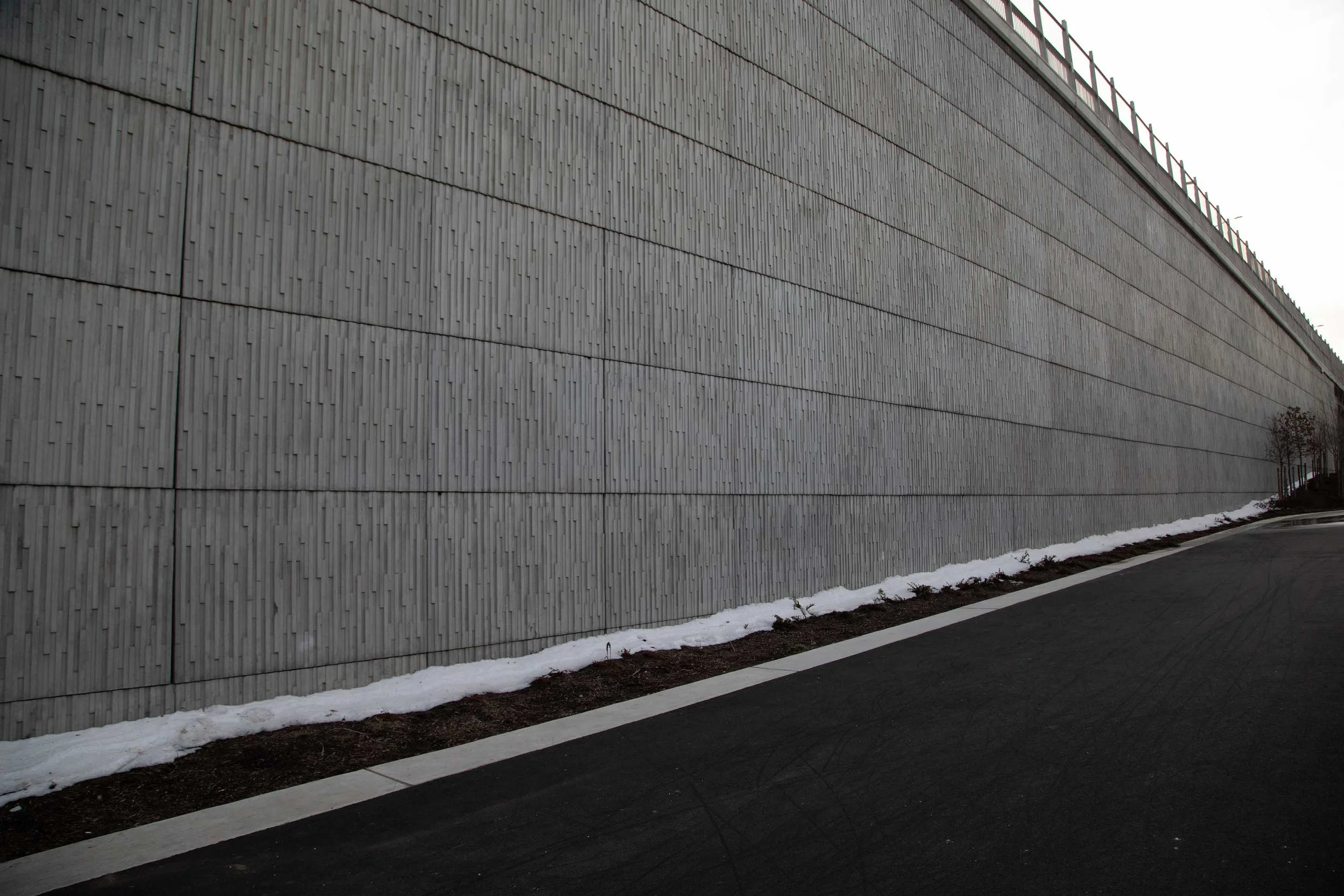
CREDITS
-
Written and produced by Miles Francis
Mixed by Andrew Lappin at Sunset Sound Recorders, LA
Mastered by Joe LaPorta at Sterling Sound
Additional engineering by David Plowman at Patchwork Sound, Toronto
Additional arranging by Michael Harlen
Recorded in NYC (Cornelia Street Studio) and Gabriola Island (The Cabin)
All songs ℗© 2022 Miles Francis
All photos © Charles Billot
This project has been made possible in part by the Government of Canada and FACTOR (The Foundation Assisting Canadian Talent on Recordings).
-
Background vocals: Lizzie Loveless, Lou Tides
Shekeres: Lollise Mbi, Giancarlo Luiggi
Violins: Camellia Hartman, Meitar Forkosh
Viola: Midori Witkoski
Baritone saxophone: Maria Christina Eisen
Trumpet and euphonium: Leif Arntzen
All other instruments performed by Miles Francis
-
Film and photo: Charles Billot
Hair and makeup: Nina Carelli
Graphic design: The Collected Works
Content manager: Silverman Enterprises
-
Thank you to my family in NY and Canada; to my parents, Kathy and Leif - this album is dedicated to you; to Lizzie <3 and Tony; to Charles Billot; to all of my friends and loved ones who have supported me through the years; to Teeny and the entire Lieberson family; to the Cornelia Street Sessions crew; to my teachers; to Will Butler, Antibalas, EMEFE and Superhuman Happiness; to all of the musicians who have played my songs onstage with me; to the Black Trans Liberation/Stonewall Protests/Musicians United communities; to Sound Mind Collective/Womxn Musicians Forum; to Steve Dalmer & Invasion Group, Joni Daniels @ Treefort Artists & AJ Tobey @ Rough Trade Publishing; to Tony Allen, my favorite drummer; and to you - thank you for listening.


